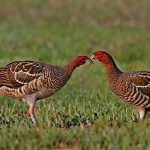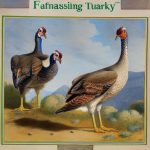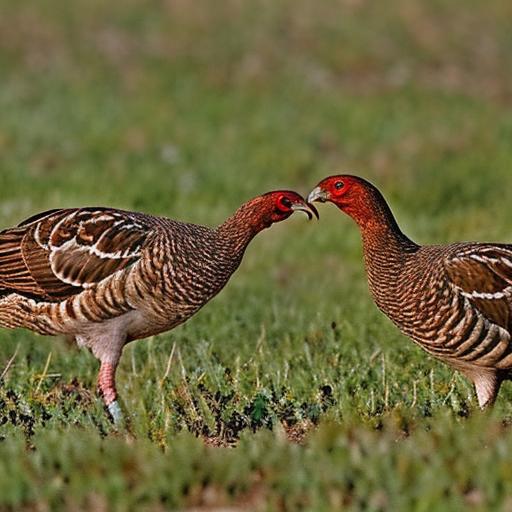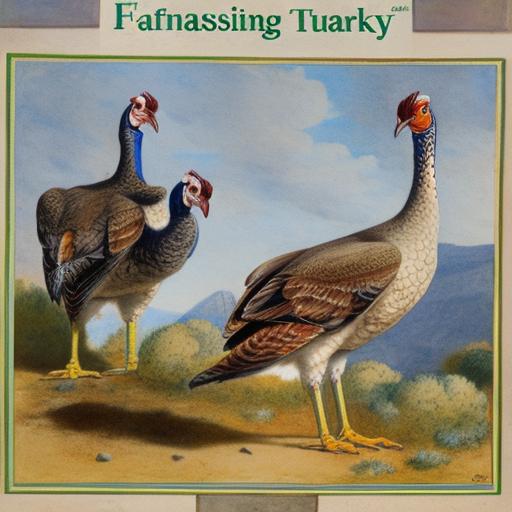Turkey breeding season is an important time for turkey farmers and breeders. It is the period when turkeys naturally engage in mating and reproduction. This season typically occurs in the spring, as the days get longer and the weather becomes warmer. During this time, male turkeys, known as toms, become more active and display their vibrant plumage to attract female turkeys, known as hens. The breeding season is crucial for the continuation of turkey populations and the production of turkey meat and eggs. Understanding the natural breeding cycle of turkeys, the factors affecting the breeding season, and the signs of breeding readiness are essential for successful turkey farming.
Key Takeaways
- Turkey breeding season typically occurs in the spring and early summer, when the days are longer and the weather is warmer.
- Understanding the natural breeding cycle of turkeys is important for successful breeding and hatching of eggs.
- Factors affecting turkey breeding season include daylight length, temperature, nutrition, and the presence of predators.
- Signs of turkey breeding season include increased vocalization, strutting behavior, and the formation of mating pairs.
- The importance of turkey breeding season lies in the production of fertile eggs for hatching and the continuation of the turkey population.
Understanding the Natural Breeding Cycle of Turkeys
The natural breeding cycle of turkeys is influenced by environmental factors such as daylight length, temperature, and food availability. As the days get longer in the spring, turkeys experience an increase in reproductive hormones, which triggers mating behavior. Toms become more vocal and display their feathers to attract hens. Hens also become more receptive to mating during this time. Once mating occurs, hens will begin to lay eggs, typically one egg per day, until they have a clutch of eggs. The incubation period for turkey eggs is around 28 days, after which poults (baby turkeys) hatch. Understanding this natural breeding cycle is important for turkey farmers to optimize breeding conditions and maximize reproductive success.
During the breeding season, it is important to provide turkeys with a suitable environment that mimics their natural habitat. This includes ensuring that they have access to natural light, a balanced diet, and a comfortable living space. Additionally, turkey breeders may use artificial insemination techniques to improve breeding success and genetic diversity within their flocks. By understanding the natural breeding cycle of turkeys and implementing appropriate breeding practices, farmers can ensure the health and productivity of their turkey populations.
Factors Affecting Turkey Breeding Season
Several factors can affect the timing and success of the turkey breeding season. One of the most significant factors is daylight length. As the days get longer in the spring, turkeys experience an increase in reproductive hormones, which triggers mating behavior. Temperature also plays a role in the breeding season, as warmer weather can stimulate mating behavior in turkeys. Additionally, food availability and quality can impact the breeding season, as turkeys require a balanced diet to support reproductive health.
Other factors that can affect turkey breeding season include stress, disease, and predator presence. Stressful conditions, such as overcrowding or sudden changes in environment, can disrupt mating behavior and reproductive success in turkeys. Disease outbreaks can also impact breeding season, as sick turkeys may be less likely to engage in mating behavior. Predator presence can cause stress and fear in turkeys, leading to reduced mating activity and egg production. Understanding these factors and implementing strategies to mitigate their impact is crucial for successful turkey breeding.
Signs of Turkey Breeding Season
There are several signs that indicate the onset of turkey breeding season. One of the most noticeable signs is the change in behavior of male turkeys, or toms. Toms become more vocal and display their feathers in a showy manner to attract female turkeys, or hens. This behavior is known as strutting and is a clear indication that the breeding season has begun. Additionally, hens may exhibit receptive behavior by crouching down and allowing toms to mount them.
Another sign of turkey breeding season is an increase in egg production by hens. As the breeding season progresses, hens will begin to lay eggs, typically one egg per day, until they have a clutch of eggs. This increase in egg production is a clear indication that turkeys are actively engaged in mating and reproduction. By recognizing these signs of turkey breeding season, farmers can make informed decisions about managing their flocks and optimizing breeding conditions.
Importance of Turkey Breeding Season
The turkey breeding season is of utmost importance for the continuation of turkey populations and the production of turkey meat and eggs. Without successful mating and reproduction during this time, there would be a decline in turkey populations and a decrease in the availability of turkey products. The breeding season also plays a crucial role in maintaining genetic diversity within turkey populations, which is essential for the long-term health and productivity of turkey flocks.
Furthermore, the turkey breeding season is important for sustainable turkey farming practices. By understanding and managing the breeding season effectively, farmers can ensure the health and productivity of their turkey flocks. This includes optimizing breeding conditions, monitoring reproductive health, and implementing strategies to mitigate factors that may impact breeding success. Ultimately, the importance of the turkey breeding season lies in its role in sustaining turkey populations and supporting the production of turkey meat and eggs.
Challenges and Considerations During Turkey Breeding Season

While the turkey breeding season is essential for the continuation of turkey populations, it also presents several challenges and considerations for farmers and breeders. One challenge is ensuring that turkeys have access to suitable breeding environments that mimic their natural habitat. This includes providing natural light, a balanced diet, and a comfortable living space to support mating behavior and reproductive health. Additionally, farmers may need to implement artificial insemination techniques to improve breeding success and genetic diversity within their flocks.
Another consideration during the turkey breeding season is managing factors that can impact mating behavior and reproductive success. This includes mitigating stressors such as overcrowding or sudden changes in environment that can disrupt mating behavior in turkeys. Disease outbreaks can also pose a challenge during the breeding season, as sick turkeys may be less likely to engage in mating behavior. Predator presence can cause stress and fear in turkeys, leading to reduced mating activity and egg production.
Overall, managing the challenges and considerations during the turkey breeding season requires careful planning and proactive measures to ensure the health and productivity of turkey flocks.
Managing Turkey Breeding Season
In conclusion, the turkey breeding season is a critical period for turkey farmers and breeders. Understanding the natural breeding cycle of turkeys, the factors affecting the breeding season, and the signs of breeding readiness is essential for successful turkey farming. By recognizing the signs of turkey breeding season and implementing appropriate breeding practices, farmers can optimize breeding conditions and maximize reproductive success.
The importance of the turkey breeding season lies in its role in sustaining turkey populations and supporting the production of turkey meat and eggs. However, managing the challenges and considerations during the breeding season requires careful planning and proactive measures to ensure the health and productivity of turkey flocks. By understanding and managing the turkey breeding season effectively, farmers can contribute to sustainable turkey farming practices and ensure the continuation of healthy turkey populations for years to come.
If you’re interested in learning more about poultry breeding, you might want to check out an article on how many eggs geese lay. Understanding the breeding habits of different poultry species can be fascinating and informative for anyone looking to raise birds.
FAQs
What is the turkey breeding season?
The turkey breeding season refers to the time of year when turkeys engage in mating and reproduction activities.
When does the turkey breeding season typically occur?
The turkey breeding season usually occurs in the spring, typically from March to May, when the days are longer and the weather is warmer.
What are the signs that indicate the start of the turkey breeding season?
Signs that indicate the start of the turkey breeding season include male turkeys displaying their feathers and performing courtship displays to attract females, as well as the increased vocalization and activity of both male and female turkeys.
How long does the turkey breeding season last?
The turkey breeding season can last for several weeks, during which time mating and egg-laying take place.
What factors can affect the turkey breeding season?
Factors such as weather conditions, food availability, and the overall health of the turkey population can affect the timing and success of the turkey breeding season.
Meet Walter, the feathered-friend fanatic of Florida! Nestled in the sunshine state, Walter struts through life with his feathered companions, clucking his way to happiness. With a coop that’s fancier than a five-star hotel, he’s the Don Juan of the chicken world. When he’s not teaching his hens to do the cha-cha, you’ll find him in a heated debate with his prized rooster, Sir Clucks-a-Lot. Walter’s poultry passion is no yolk; he’s the sunny-side-up guy you never knew you needed in your flock of friends!






